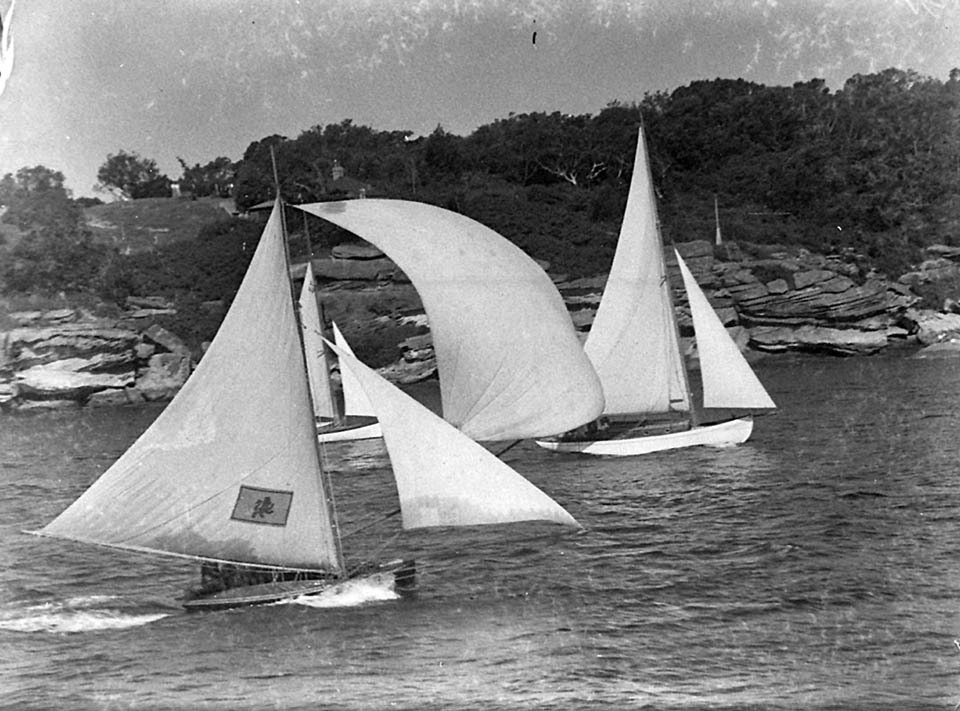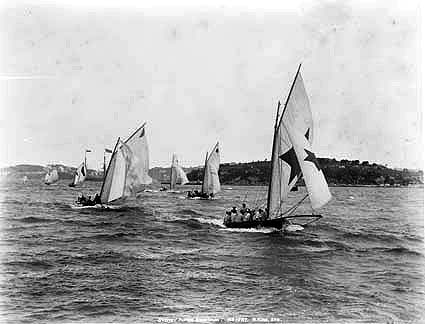The Dictionary of Sydney was archived in 2021.
18-footers
Citation
Persistent URL for this entry
To cite this entry in text
To cite this entry in a Wikipedia footnote citation
To cite this entry as a Wikipedia External link
18-footers
Joshua Slocum, an American sailor, visited Sydney Harbour part way through his circumnavigation of the world in the late nineteenth century. Slocum described the 'typical Sydney boat' as 'a handy sloop of great beam and enormous sail-carrying power'. [1] Open boats like those that Slocum described were beginning to be identified as a 'Sydney-type', at around the same time in the 1890s as the 18-footers were established as a class. [media]Since then, the image of an 18-footer in a north-east sea breeze has become synonymous with Sydney Harbour. The first 18-footers had developed from open boats that competed in matches from the early nineteenth century. Today, they are a high performance international class that has been likened to the 'Formula 1' of sailing.
Open-boat racing
[media]Eighteen-footers evolved from some of the earliest boats to be raced on Sydney Harbour. Sailors from visiting ships were known to race, 'crew against crew' in open boats that were carried aboard all large vessels. [2] These races provided training for the men, and sport for the gentlemen in the form of a wager. [3] By the 1890s, open boats had developed into a type of racing craft unique to Sydney. These shallow-draught open boats were identified as opposite to the more sedate decked-in yachts. [4] Open boats were faster, cheaper, carried large sails and a number of hands to act as 'live ballast'. A 22-foot (6.7-metre) boat could have a bumpkin extending 18 feet (5.4 metres) out in front, a main boom extending 33 feet (10 metres) back, and the highest sail 50 feet (15.2 metres) in the air. [5] Possibly carrying a greater amount of sail in proportion to length than any other type of boat in the world, they needed to be handled with care to avoid the often inevitable capsize.
Open boats were associated with the working-class suburbs of Pyrmont and Balmain. Local clubs held races for boats that ranged in length from eight to 24 feet (2.4 to 7.3 metres). [media]The racing of canvas dinghies and model boats established boat racing as a sport available to Sydney residents of all means. The smaller open-boat classes provided a base of skilled sailors for the more prestigious larger boats. All open-boat racing was popular, and attracted significant spectatorship, with steamers following even the smaller classes. The larger 22- and 24-footers were the most prestigious of the open boats. They were identified with patriotic pride as a 'national type', specific to the waters of Sydney Harbour.
Advent of the 18-footer
The development of the 18-footer as an open boat class can be largely credited to Sydney businessman Mark Foy and his establishment of the Sydney Flying Squadron in 1891. [6] [media]The Flying Squadron revolutionised open boat racing by introducing radical changes to the racing format. Triangular courses, handicap starts and sails carrying colourful insignia instead of numbers combined to increase the spectator appeal of the sport. [7] Soon after the Flying Squadron was established, Foy began to promote the 18-foot open boats instead of the larger and more common 22-footers. The 18-footers shared the same spectacular spread of sail and exciting racing as their larger cousins, but Foy considered them the more sporting type. [8] The new racing format was commercially successful, and 18-footers gradually replaced the larger open boats as the penultimate 'Sydney-type'. Intercolonial racing was also popular: a competitive fleet of 18-footers regularly raced on the Brisbane River. [9]
The 18-foot skiff
[media]If the 18-footer 'class' was established in the mid-1890s, then the 18-foot 'skiff' was established during the 1930s. By this time, 18-footer racing was a professional sport. It was estimated in 1933 that over 3000 paying spectators would follow Saturday's racing aboard a number of specially chartered steamers. [10] [media]In 1933, a new 'skiff-type' 18-footer, Aberdare, was built in Brisbane. Aberdare had a narrow beam, reduced sail area and no 'heel' underwater. [11] She was faster than any traditional Sydney 18-footer. Fearing that the reduced sail area and reduced crew would lead to the demise of the class's popularity, the Sydney Flying Squadron conservatively banned the new 'skiff type'. [12]
As a reaction to the ban, 'veteran sporting entrepreneur', James J Giltinan established a breakaway club called the New South Wales 18-Footers League in 1935. The move was reminiscent of the creation of the rugby league code of football, also initiated by Giltinan. [media]The Sunday races, sailed from the League Club at Double Bay, were almost an instant success, as no other sporting events were held on Sundays. [13] The years between the formation of the League and the beginning of World War II were the busiest and most popular years of 18-footer racing. Gambling was part of the attraction. Anecdotes refer to police raids on the steamers and at popular vantage points on the shore, in an attempt to prevent illegal betting. [14]
Postwar changes
Few 18-footers have epitomised the postwar development of the 18-footer class as well as Bob Miller's boats Taipan and Venom, built in Brisbane in the early 1960s. These skiffs were built radically lightweight, had innovative design features, and with a crew of three they could plane upwind. [15] Like the 'skiff-type' 18-footers of the 1930s, the lightweight 18s initially met with resistance. [16] The small crew of three challenged the egalitarian traditions of participation that the larger boats had been based on. However, within 10 years most of the features seen on Taipan and Venom had become commonplace on Sydney Harbour.
Shifts away from gambling were subtler than changes in 18-footer design. Eighteen-footer racing on the harbour remained popular as the boats became lighter and faster. The exceptionally high speeds, spectacular capsizes, and close racing were enough to maintain a spectator base. [media]However, spectatorship changed as the racing attracted newspaper, radio and television coverage. The economy of 18-footer racing gradually shifted away from steamer patronage, and towards advertising and sponsorship. By the 1970s, sponsors' logos had replaced the colourful insignia used to identify the different boats, and betting was no longer the mainstay of the sport. [17]
Today, both old and new 18-footers can be seen racing on Sydney Harbour. The Historic 18-Foot Skiff Sailing Association races a fleet of replica 18-footers out of the Sydney Flying Squadron, alongside their modern counterparts. Famous replicas such as Britannia and Aberdare keep the old traditions of the 18-footers alive. The modern 18-footers, with extended wings, trapeze, and carbon-fibre construction, barely resemble the original boats. However the excitement of sailing 'on the edge', the relatively large sail areas, spectator appeal and association with Sydney Harbour all remain.
References
M Molloy, A Century of Sydney's Flying Sailors, Sydney Flying Squadron, Sydney, 1991
L d'Alpuget, Yachting in Australia, Hutchinson, Richmond, 1980
Notes
[1] J Slocum, Sailing Alone Around the World, Sheridan House, New York, 1954 (c1899), p 170
[2] 'Sailing', Sydney Mail, 30 January 1897
[3] J Cumes, Their Chastity was not too Rigid: Leisure Times in Early Australia, Longman Cheshire/Reed, Melbourne, 1979, p 157–58
[4] R Mallory, 'Yacht types in Australian Waters', Southern Cross, vol 1, no 2, 12 December 1898, pp 31–35
[5] 'Tom Tug', 'Open Boat Sailing in Port Jackson', Australian Country Life, April 1907, p 32–33
[6] M Molloy, A Century of Sydney's Flying Sailors, Sydney Flying Squadron, Sydney, 1991, pp 11–16
[7] M Foy, 'Sailing', pamphlet held by Mitchell Library, State Library of New South Wales, no date
[8] M Molloy, A Century of Sydney's Flying Sailors, Sydney Flying Squadron, Sydney, 1991, p 17
[9] L d'Alpuget, Yachting in Australia, Hutchinson, Richmond, 1980, p 41
[10] 'HP', 'Skiff type 18-footer', Open Boat, 7 October 1933, p 28
[11] L d'Alpuget, Yachting in Australia, Hutchinson, Richmond, 1980, p 157
[12] 'HP', 'Skiff type 18-footer', Open Boat, 7 October 1933, p 28
[13] L d'Alpuget, Yachting in Australia, Hutchinson, Richmond, 1980, p 157
[14] B Brown, Penniless Millionaire: Tales of a Shoestring Yachtsman, Panda Books, Millfield, 1989, p 27
[15] 'Taipan', Australian Register of Historic Vessels, Australian National Maritime Museum
[16] M Molloy, A Century of Sydney's Flying Sailors, Sydney Flying Squadron, Sydney, 1991, p 70
[17] L d'Alpuget, Yachting in Australia, Hutchinson, Richmond, 1980, p 161
.









